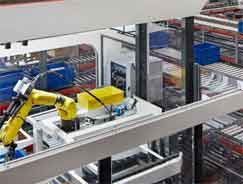Finding robots that can handle piece picking – selecting one item at a time in random environments - remains a real challenge.
Recently, we reported on a Polish company named NoMagic that had received $8.6 million in funding for its robot software that the company claims represents a breakthrough in picking technology, leveraging an advanced vision system and – what else – artificial intelligence. (See Has Polish Startup Solved Piece-Picking Challenge?)
Supply Chain Digest Says...
|
 |
The Times article notes that Knapp developing warehouse designs for facilities staffed by robots rather than humans. |
 |
What do you say? |
| Click here to send us your comments |
 |
| Click here to see reader feedback |
|
The job is hard. A few months ago, SCDigest reported on a patent filing from Amazon that noted the challenge of tweaking robotic picking systems to deal with new items with different size and shapes. The result are frequent "drops" by the robotic arms, requiring a technician to make tweaks to solve the issue. But that's expensive to do across many items.
The Amazon patent filing describes a new type of control system that uses machine learning to self-adjust. The robots would be provisioned with a variety of sensors and tracking capabilities so that the control system knows the action involved, what item was being picked, some information about the drop and more.
But given the likely size of the prize in an ecommerce world driven by piece-picking, many companies are pursuing solutions to the problem. That includes a company called Covariant.AI, which also appears to be close, building on research started at the University of California, Berkeley.
"Their technology is an indication that, in the coming years, few warehouse tasks will be too small or complex for a robot," says a recent article about the technology in the New York Times, adding that "as the machines master tasks traditionally handled by humans, their development raises new concerns about warehouse workers losing their jobs to automation."
After seeing the Convariant.AI-powered robot deftly and accurately select small and varied electrical components from a tote at a factory in Germany, the Times quotes Peter Puchwein, vice president of well-known Australian materials handling company Knapp as saying "I've worked in the logistics industry for more than 16 years and I've never seen anything like this.
Knaap has a partnership with Covariant.
It will take many years for widespread adoption of these and related technologies for case picking as well as piece picking, but in the end "at some point most warehouse tasks will be done by machines. Human workers will need to find other things to do," the Times article says.
Naturally, artificial intelligence, as the company name makes clear, is critical to Covariant.AI's approach. The company uses a form of artificial intelligence called reinforcement learning, under which the robots learn new tasks on their own through extreme trial and error.
Why is piece picking so hard? Shapes and surfaces can vary significantly. One light switch might be upside down, the other right-side up. The next electrical gadget might be in a plastic bag that reflects light in ways a robot has never seen.
(See More Below)
|
CATEGORY SPONSOR: SOFTEON |
|
|
| |
|
|
Until now, it required a human being to deal with all that variability.
But now, AI might just be able to do the job. In developing Covariant's system, company engineers created diverse set of virtual objects that the robots could learn to select.
 Now, Covariant says at the German factory, its robot can pick and sort more than 10,000 different items, with more than 99% accuracy, the company says. Now, Covariant says at the German factory, its robot can pick and sort more than 10,000 different items, with more than 99% accuracy, the company says.
Last year, giant automation vendor ABB had a piece-picking contest, in which 20 firms participated.
Covariant was the only company that could handle every task as quickly and accurately as a human.
The Times article notes that Knapp developing warehouse designs for facilities staffed by robots rather than humans. Such warehouses would allow for items to be more densely packed into spaces and retrieved by robots trained to perform the task.
"The new warehouses will be built around AI robots and not humans," Puchwein said.
SCDigest notes: It's not a question of it but when. Hopefully, the transformation from humans to robots in distribution will take place gradually, giving people and the economy time to adjust.
Do you think robotic piece picking is almost here? How fast will it be deployed? Let us know your thoughts at the Feedback section below.
|